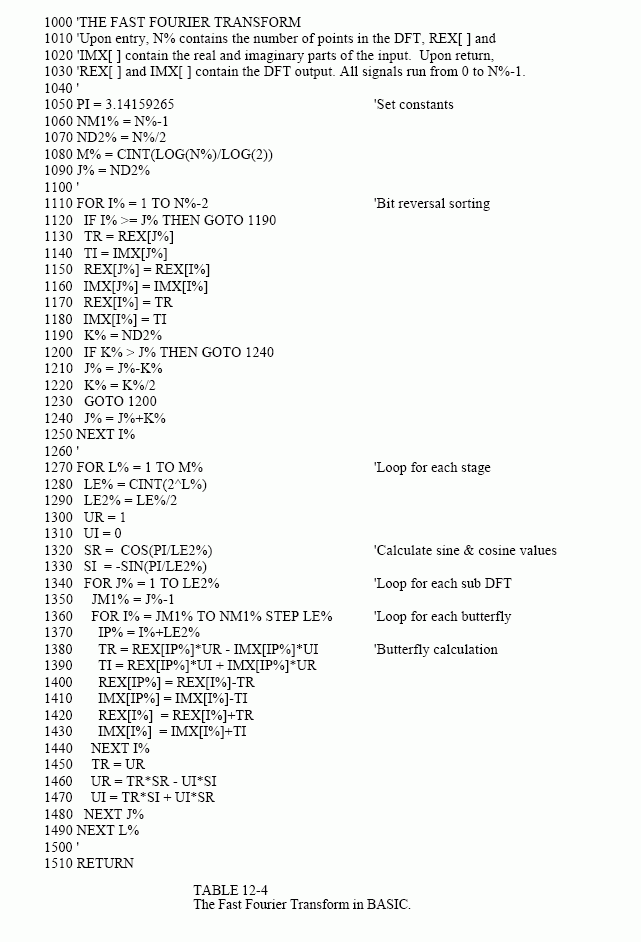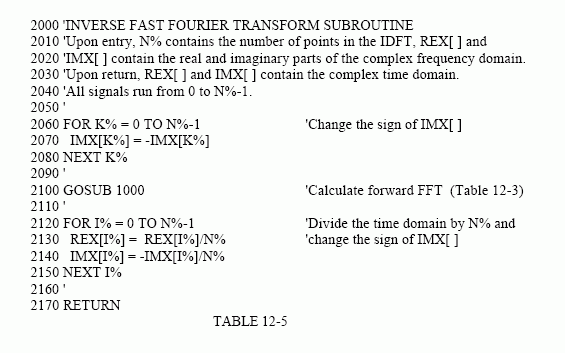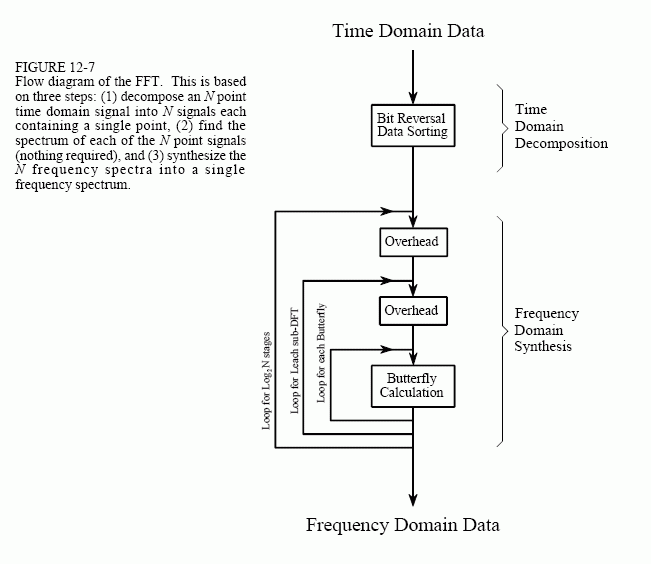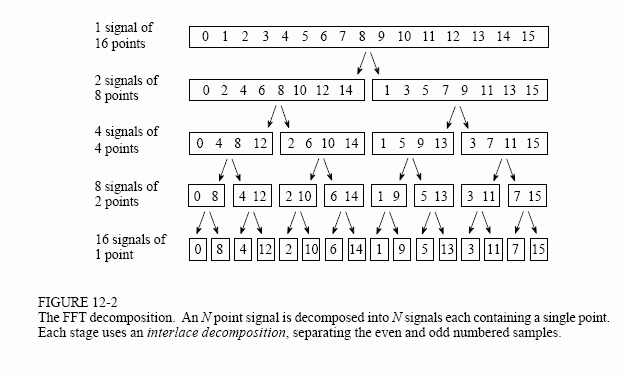FFT算法的完整DSP实现
傅里叶变换或者FFT的理论参考:
[1] http://www.dspguide.com/ch12/2.htm
The Scientist and Engineer's Guide to Digital Signal Processing, By Steven W. Smith, Ph.D.
[2] http://blog.csdn.net/v_JULY_v/article/details/6196862,可当作[1]的中文参考
[3] 任意一本数字信号处理教材,上面都有详细的推导DCT求解转换为FFT求解的过程
[4] TI文档:基于TMS320C64x+DSP的FFT实现。 使用baidu/google可以搜索到。
1. 有关FFT理论的一点小小解释
关于FFT这里只想提到两点:
(1)DFT变换对的表达式(必须记住)
—— 称旋转因子
(2)FFT用途——目标只有一个,加速DFT的计算效率。
DFT计算X(k)需要N^2次复数乘法和N(N-1)次复数加法;FFT将N^2的计算量降为。
“FFT其实是很难的东西,即使常年在这个领域下打拼的科学家也未必能很好的写出FFT的算法。”——摘自参考上面提供的参考文献[1]
因此,我们不必太过纠结于细节,当明白FFT理论后,将已有的算法挪过来用就OK了,不必为闭着教材写不出FFT而郁闷不堪。
FFT的BASIC程序伪代码如下:

IFFT的BASIC程序伪代码如下(IFFT通过调用FFT计算):

FFT算法的流程图如下图,总结为3过程3循环:
(1)3过程:单点时域分解(倒位序过程) + 单点时域计算单点频谱 + 频域合成
(2)3循环:外循环——分解次数,中循环——sub-DFT运算,内循环——2点蝶形算法

分解过程或者说倒位序的获得参考下图理解:

2. FFT的DSP实现
下面为本人使用C语言实现的FFT及IFFT算法实例,能计算任意以2为对数底的采样点数的FFT,算法参考上面给的流程图。
/*
* zx_fft.h
*
* Created on: 2013-8-5
* Author: monkeyzx
*/ #ifndef ZX_FFT_H_
#define ZX_FFT_H_ typedef float FFT_TYPE; #ifndef PI
#define PI (3.14159265f)
#endif typedef struct complex_st {
FFT_TYPE real;
FFT_TYPE img;
} complex; int fft(complex *x, int N);
int ifft(complex *x, int N);
void zx_fft(void); #endif /* ZX_FFT_H_ */
/*
* zx_fft.c
*
* Implementation of Fast Fourier Transform(FFT)
* and reversal Fast Fourier Transform(IFFT)
*
* Created on: 2013-8-5
* Author: monkeyzx
*/ #include "zx_fft.h"
#include <math.h>
#include <stdlib.h> /*
* Bit Reverse
* === Input ===
* x : complex numbers
* n : nodes of FFT. @N should be power of 2, that is 2^(*)
* l : count by bit of binary format, @l=CEIL{log2(n)}
* === Output ===
* r : results after reversed.
* Note: I use a local variable @temp that result @r can be set
* to @x and won't overlap.
*/
static void BitReverse(complex *x, complex *r, int n, int l)
{
int i = 0;
int j = 0;
short stk = 0;
static complex *temp = 0; temp = (complex *)malloc(sizeof(complex) * n);
if (!temp) {
return;
} for(i=0; i<n; i++) {
stk = 0;
j = 0;
do {
stk |= (i>>(j++)) & 0x01;
if(j<l)
{
stk <<= 1;
}
}while(j<l); if(stk < n) { /* 满足倒位序输出 */
temp[stk] = x[i];
}
}
/* copy @temp to @r */
for (i=0; i<n; i++) {
r[i] = temp[i];
}
free(temp);
} /*
* FFT Algorithm
* === Inputs ===
* x : complex numbers
* N : nodes of FFT. @N should be power of 2, that is 2^(*)
* === Output ===
* the @x contains the result of FFT algorithm, so the original data
* in @x is destroyed, please store them before using FFT.
*/
int fft(complex *x, int N)
{
int i,j,l,ip;
static int M = 0;
static int le,le2;
static FFT_TYPE sR,sI,tR,tI,uR,uI; M = (int)(log(N) / log(2)); /*
* bit reversal sorting
*/
BitReverse(x,x,N,M); /*
* For Loops
*/
for (l=1; l<=M; l++) { /* loop for ceil{log2(N)} */
le = (int)pow(2,l);
le2 = (int)(le / 2);
uR = 1;
uI = 0;
sR = cos(PI / le2);
sI = -sin(PI / le2);
for (j=1; j<=le2; j++) { /* loop for each sub DFT */
//jm1 = j - 1;
for (i=j-1; i<=N-1; i+=le) { /* loop for each butterfly */
ip = i + le2;
tR = x[ip].real * uR - x[ip].img * uI;
tI = x[ip].real * uI + x[ip].img * uR;
x[ip].real = x[i].real - tR;
x[ip].img = x[i].img - tI;
x[i].real += tR;
x[i].img += tI;
} /* Next i */
tR = uR;
uR = tR * sR - uI * sI;
uI = tR * sI + uI *sR;
} /* Next j */
} /* Next l */ return 0;
} /*
* Inverse FFT Algorithm
* === Inputs ===
* x : complex numbers
* N : nodes of FFT. @N should be power of 2, that is 2^(*)
* === Output ===
* the @x contains the result of FFT algorithm, so the original data
* in @x is destroyed, please store them before using FFT.
*/
int ifft(complex *x, int N)
{
int k = 0; for (k=0; k<=N-1; k++) {
x[k].img = -x[k].img;
} fft(x, N); /* using FFT */ for (k=0; k<=N-1; k++) {
x[k].real = x[k].real / N;
x[k].img = -x[k].img / N;
} return 0;
} /*
* Code below is an example of using FFT and IFFT.
*/
#define SAMPLE_NODES (128)
complex x[SAMPLE_NODES];
int INPUT[SAMPLE_NODES];
int OUTPUT[SAMPLE_NODES]; static void MakeInput()
{
int i; for ( i=0;i<SAMPLE_NODES;i++ )
{
x[i].real = sin(PI*2*i/SAMPLE_NODES);
x[i].img = 0.0f;
INPUT[i]=sin(PI*2*i/SAMPLE_NODES)*1024;
}
} static void MakeOutput()
{
int i; for ( i=0;i<SAMPLE_NODES;i++ )
{
OUTPUT[i] = sqrt(x[i].real*x[i].real + x[i].img*x[i].img)*1024;
}
} void zx_fft(void)
{
MakeInput(); fft(x,128);
MakeOutput(); ifft(x,128);
MakeOutput();
}
程序在TMS320C6713上实验,主函数中调用zx_fft()函数即可。
FFT的采样点数为128,输入信号的实数域为正弦信号,虚数域为0,数据精度定义FFT_TYPE为float类型,MakeInput和MakeOutput函数分别用于产生输入数据INPUT和输出数据OUTPUT的函数,便于使用CCS 的Graph功能绘制波形图。这里调试时使用CCS v5中的Tools -> Graph功能得到下面的波形图(怎么用自己琢磨,不会的使用CCS 的Help)。
输入波形
输入信号的频域幅值表示
FFT运算结果
对FFT运算结果逆变换(IFFT)
如何检验运算结果是否正确呢?有几种方法:
(1)使用matlab验证,下面为相同情况的matlab图形验证代码
SAMPLE_NODES = 128;
i = 1:SAMPLE_NODES;
x = sin(pi*2*i / SAMPLE_NODES); subplot(2,2,1); plot(x);title('Inputs');
axis([0 128 -1 1]); y = fft(x, SAMPLE_NODES);
subplot(2,2,2); plot(abs(y));title('FFT');
axis([0 128 0 80]); z = ifft(y, SAMPLE_NODES);
subplot(2,2,3); plot(abs(z));title('IFFT');
axis([0 128 0 1]);
(2)使用IFFT验证:输入信号的FFT获得的信号再IFFT,则的到的信号与原信号相同
可能大家发现输入信号上面的最后IFFT的信号似乎不同,这是因为FFT和IFFT存在精度截断误差(也叫数据截断噪声,意思就是说,我们使用的float数据类型数据位数有限,没法完全保留原始信号的信息)。因此,IFFT之后是复数(数据截断噪声引入了虚数域,只不过值很小),所以在绘图时使用了计算幅值的方法,
C代码中:
OUTPUT[i] = sqrt(x[i].real*x[i].real + x[i].img*x[i].img)*1024;
matlab代码中:
subplot(2,2,3); plot(abs(z));title('IFFT');
所以IFFT的结果将sin函数的负y轴数据翻到了正y轴。另外,在CCS v5的图形中我们将显示信号的幅度放大了1024倍便于观察,而matlab中没有放大。
FFT算法的完整DSP实现的更多相关文章
- FFT算法的完整DSP实现(转)
源:FFT算法的完整DSP实现 傅里叶变换或者FFT的理论参考: [1] http://www.dspguide.com/ch12/2.htm The Scientist and Engineer's ...
- FFT算法
FFT算法的完整DSP实现 傅里叶变换或者FFT的理论参考: [1] http://www.dspguide.com/ch12/2.htm The Scientist and Engineer's G ...
- msp430学习笔记-实现开方log等计算及FFT算法(待续)
MSP430 FFT算法实现 http://bbs.21ic.com/icview-391532-1-1.html http://blog.sina.com.cn/s/blog_6cd2030b010 ...
- 基于傅里叶变换的音频重采样算法 (附完整c代码)
前面有提到音频采样算法: WebRTC 音频采样算法 附完整C++示例代码 简洁明了的插值音频重采样算法例子 (附完整C代码) 近段时间有不少朋友给我写过邮件,说了一些他们使用的情况和问题. 坦白讲, ...
- 音频降噪算法 附完整C代码
降噪是音频图像算法中的必不可少的. 目的肯定是让图片或语音 更加自然平滑,简而言之,美化. 图像算法和音频算法 都有其共通点. 图像是偏向 空间 处理,例如图片中的某个区域. 图像很多时候是以二维数据 ...
- mser 最大稳定极值区域(文字区域定位)算法 附完整C代码
mser 的全称:Maximally Stable Extremal Regions 第一次听说这个算法时,是来自当时部门的一个同事, 提及到他的项目用它来做文字区域的定位,对这个算法做了一些优化. ...
- 音频自动增益 与 静音检测 算法 附完整C代码
前面分享过一个算法<音频增益响度分析 ReplayGain 附完整C代码示例> 主要用于评估一定长度音频的音量强度, 而分析之后,很多类似的需求,肯定是做音频增益,提高音量诸如此类做法. ...
- 快速傅立叶变换(FFT)算法
已知多项式f(x)=a0+a1x+a2x2+...+am-1xm-1, g(x)=b0+b1x+b2x2+...+bn-1xn-1.利用卷积的蛮力算法,得到h(x)=f(x)g(x),这一过程的时间复 ...
- 用C实现FFT算法
用C语言编写FFT算法 转http://blog.sina.com.cn/s/blog_65d639d50101buo1.html #include "math.h" #defi ...
随机推荐
- python基础===进程,线程,协程的区别(转)
本文转自:http://blog.csdn.net/hairetz/article/details/16119911 进程拥有自己独立的堆和栈,既不共享堆,亦不共享栈,进程由操作系统调度. 线程拥有自 ...
- 【bzoj1026】windy数
江泽OJ好,远离bzoj保平安. 仍然沿用之前的记忆化搜索的办法即可. #include<bits/stdc++.h> #define N 10010 using namespace st ...
- python多进程处理数据
当我们处理大规模数据如ImageNet的时候,单进程显得很吃力耗时,且不能充分利用多核CPU计算机的资源.因此需要使用多进程对数据进行并行处理,然后将结果合并即可.以下给出的是多进程处理的demo代码 ...
- [How to]集成SQLite3
1.简介 本文将介绍IOS的开发过程中如何集成Sqlite的方法,目前Sqlite的版本为3,所以我们称之为Sqlite3. 在本文中我将介绍Sqlite3的开发配置,本地Sqlite3数据库的建立通 ...
- mongodb实现批量修改数据
var rds = db.REGIPATIENTREC.find({mzh:{$lt:"0"},usrOrg:"石景山中西医结合医院"}); var show ...
- Fel表达式实践
项目背景 订单完成后,会由交易系统推送实时MQ消息给订单清算系统,告诉清算系统此订单交易完成,可以进行给商家结算等后续操作. 财务要求在交易推送订单到清算系统时和订单清算系统接收到订单消息后,需要按照 ...
- css文件放在头部的原因
我在博问上发的一个这个问题 然后有人这样回复我的 我感觉很有道理的样子 所以我放上来了 这样会先加载css的样式,在渲染dom的时候已经知道了自己的样式了,所以一次渲染成功 如果css放在底部,那么需 ...
- 光流optical flow基本原理与实现
光流(optical flow)是什么呢?名字很专业,感觉很陌生,但本质上,我们是最熟悉不过的了.因为这种视觉现象我们每天都在经历.从本质上说,光流就是你在这个运动着的世界里感觉到的明显的视觉运动(呵 ...
- matlab基本指令
基本命令 close all //关闭所有figure 命令打开的窗口,在命令窗口输入 clear all //清除之前运行程序所存下的所有变量 size(mat) a = [1 2 3 ; 4 5 ...
- jdk1.6错误:no such provider: BC jdk1.6支持SSL问题
程序调用https请求,由于jdk1.6只支持1024的DH,需要调整 1.在$JAVA_HOME/jre/lib/ext 下添加加密组件包 bcprov-jdk15on-1.52.jar和bcpro ...





